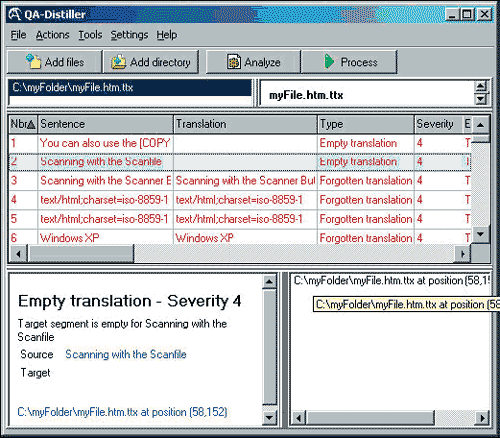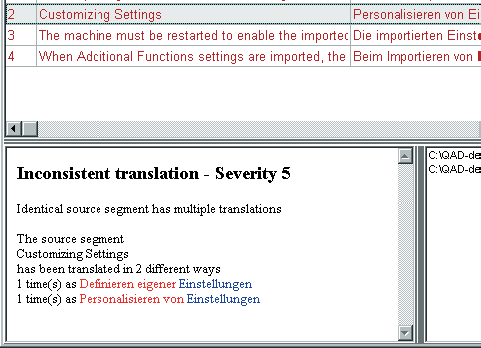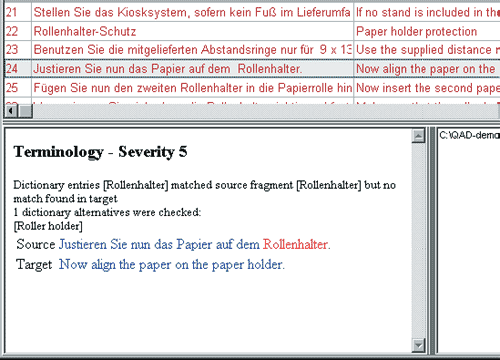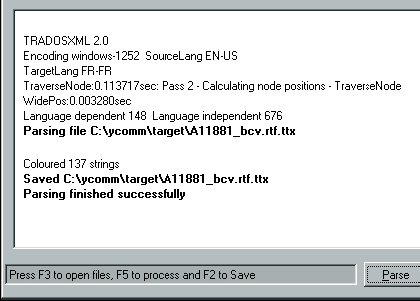Automated translation quality control
By Nathalie De Sutter,
YAMAGATA EUROPE,
Gent (SDW) BELGIUM
nathalie at yamagata-europe.com
https://www.yamagata-europe.com/
Become a member of TranslationDirectory.com at just
$12 per month (paid per year)
 Nathalie
De Sutter discusses how new technologies can mitigate
the threats faced by Language Service Providers (LSPs). Nathalie
De Sutter discusses how new technologies can mitigate
the threats faced by Language Service Providers (LSPs).
All
maturing industries try to
avoid their products being seen as
commodities that can easily be bought
from any supplier; localisation and
translation service providers are no
exception. In most cases, translation
does not pertain to the core business of
the customer, who therefore considers
it to be a ‘non-critical’ purchase.
This, combined with the decreasing
complexity of the supply market,
increasing competition and more
professional purchasing behaviour,
results in the perception of localisation
as a commodity. Customers demand
greater flexibility, with higher volumes
to be processed and shorter deadlines.
One indicator is the practice of
auctioning assignments of translation
projects.
Differentiate
or innovate
Many companies seek refuge by positioning themselves
as ‘highquality providers’ and strive toward a conscious
commitment to quality as a differentiator. However,
as we operate in a perceived commodity market, we
should be aware that companies are not necessarily
willing to pay extra for this and that the trinity
— high quality, on time and at a minimum price — is
often seen as a minimum requirement. Offering a better-than-acceptable
level of quality without missing any deadlines at
lower cost requires considerable process innovation.
Kaizen™ revisited
After falling out of fashion for over a decade, and
thanks to the great performance of companies like
Toyota, there is renewed managerial interest in Japanese
management techniques and the Japanese philosophy
of quality thinking. One of the principal concepts
in the work of Masaaki Imai, founder of the Kaizen
Institute, is that quality improvement and cost reduction
are, in fact, compatible.
What
more has Kaizen taught us? First of all, quality is
the responsibility of everyone in the organisation
and not exclusively of the quality department. Indeed,
fighting non-value-adding activities, or Muda,
should be one of the key activities of all members
of organisations striving for continuous improvement
or Kaizen. A second insight relates to the
fact that quality improvement, contrary to traditional
belief, has a cost-reducing effect. ‘Doing it right
the first time’ may require an initial investment,
but the long-term impact generates many advantages
outside the limited framework of quality. Spending
money on quality seems inevitable; how much money,
however, depends on when you intend to spend it.
Go
to Gemba
The first implementation rule in Kaizen is ‘Go to
Gemba first!’ Gemba means ‘real place’ but,
in quality lingo, refers to ‘the workplace’. So ‘go
to Gemba’ means go to the shop floor, observe, measure
and take immediate action — something the translation
industry is very good at. We are flexible and will
solve or fix any problem. However, Mr Imai takes this
a step further: the immediate action is only a temporary
countermeasure. It is more important to find the root
cause of the problem and subsequently standardise
so as to create the necessary procedures and tools
to prevent a reoccurrence. This is exactly what our
industry should do. In our hurry to consolidate and
become a value creator, we have lost touch with the
Gemba.
Doing
it right the first time
Traditionally, in order to verify the quality of a
translation, a revision by a second — usually senior
— translator is carried out, a custom that is certainly
expensive and time-consuming. Another possibility
is to have the more experienced translator make the
initial translation and a second person, who has yet
to master the craft, proof the text to detect and
eliminate inaccuracies and imperfections such as incorrectly
formatted numbers, and punctuation errors and omissions.
This approach not only makes the junior translator
more familiar with certain technical subjects, it
also strips the translated text from those
small defects that typically annoy the reader. It
was precisely this last scenario that Ycomm was determined
to automate. The notion that everything that is measurable
is also traceable could be moulded into a software
application that would eliminate most of the repetitive
and predictable (formal) mistakes right after initial
translation. This would not only improve the translation’s
quality, but also avoid corrective and often redundant
actions afterwards, such as updating the translation
memories or making corrections at the DTP stage. Furthermore,
such a checker would be able to locate mistakes that
are very difficult to spot ‘manually’, such as the
inconsistent application of a 3000-word terminology
list.
Automated
translation quality control
QA Distiller™ enables us to locate omissions, inconsistencies,
formatting problems and terminology mistakes in bilingual
files (.ttx, .rtf and .tmx), and also allows the rapid
correction of these mistakes by taking us directly
from the reported error to the problem in the text.
An omission has occurred if a segment in the source
text has no acceptable counterpart in the target text
(Figure 1). It is possible that the translator skipped
the source segment, or that the target segment is
either empty or contains (partially) identical text
as compared to the source language segment. It is
indispensable for technical translations to be consistent:
assuming that identical source segments should have
identical targets, a consistency check can easily
be automated by comparing the content of these segments.

Figure
1. Error message generation on an omitted translation
QA
Distiller™ also checks for a number of language-dependent
formatting irregularities. It will, for example, verify
whether a translation contains any characters that
do not pertain to the valid Unicode range of the language
in question. It checks whether punctuation is correct,
whether numbers are identical in the source and target
(and are correctly formatted), and that no suspicious
multiple spaces and tabs occur in the text. Last but
not least, it contains a terminology checker that
verifies whether each term in the source text has
been translated in accordance with one or more loaded
dictionaries.
It is true that these errors only indicate the more
‘formal’ translation mistakes. Other possible problems
such as style, fluency, register and grammar are ignored,
making this quality checker suitable only for texts
that are repetitive or deal with highly specialised
subjects, a point that is equally applicable to the
use of translation memories in general. In addition,
proofreading may still be necessary.
Formal
mistakes, however, are usually indicative of other
severe quality issues in a translation and their detection
allows us to evaluate our suppliers more objectively.
Vendor evaluation and selection is, after all, one
of the most critical activities in a business model
that depends to a large extent on outsourcing. Discussions
about style preferences or the choice between equally
correct terms have often led to never-ending discussions,
whereas formal mistakes such as inconsistent translations
(Figure 2), untranslated text and incorrectly formatted
numbers (for example 0.12 instead of 0,12 in French)
are objectively incorrect in technical manuals. Total
quality assurance obviously requires an integrated
approach, but every step toward a better translation
is progress.

Figure 2.
Inconsistent translation
A
check with QA Distiller™ also works for the
verification and cleanup of translation memories,
thus preventing the dreaded ‘garbage in, garbage out’
effect that should always be taken into consideration
when previous translations are recycled. Some errors
will be generated only if there is a discrepancy between
source and target text (Figure 3). QA Distiller is
basically a comparison tool, based on the assumption
that there is a certain level of correspondence between
the source and target text. This
implies that, if the source text itself contains errors
or ambiguities, QA Distiller™ may not be able
to identify related mistakes in the target text. This
takes us to another discussion on which I will comment
very briefly: clients should not penalise translation
suppliers for errors that are caused by faulty source
documents.

Figure 3. Terminology mistake
Reducing
proofreading efforts
Eliminating
mistakes at an early stage saves time at the proofreading
stage. However, there is a second way to reduce effort:
proofreaders often revise texts that have already
been validated, as the text was initially extracted
from a translation memory or is the result of a pre-translation
process. ColourTagger™ is a tool that colours
translated text based upon its recuperation level
from Trados™ XTranslate or a Trados™ translation
memory, and presents the results in a laid-out FrameMaker™
or HTML document that includes illustrations (Figure
5). If 75% of a manual has been generated from a validated
translation memory, the proofreader may want to skip
these parts and concentrate on the sections containing
new text.
Figure 4. Implementing QA
Distiller™ in the localisation process
Get
what you expect
Nevertheless, perception of the overall quality of
a translation project is still relative, as it is
defined by the client’s expectations. Making these
explicit and communicating them upstream will avoid
unnecessary discussions and misunderstandings. Perhaps
you have also encountered the situation in which translation
memory and glossary, both provided by the customer,
are inconsistent. A quick terminology check of the
translation memory will give you immediate proof of
this, and discussing this with your customer before
the next translation project kicks off is definitely
a good idea. Ask the customer to decide which reference
material has priority and implement corrections if
necessary.
A
well-defined division of tasks and an open communication
between you and your (freelance) supplier are equally
vital. Figure 4 illustrates how tasks may be allocated.
The translator runs a spelling and grammar check on
the translation before delivering it, while the translation
company commits itself to verifying the quality of
a translation memory before forcing the freelancers
to give discounts on recuperated segments that may
still require complete revision and editing.

Figure 5.
Parsing bilingual files in ColourTagger™
Kaizen
in translation
These approaches are closely related to the insights
provided by Japanese quality thinking described at
the start of this article: everyone involved in a
translation project monitors the quality at every
stage of the process. Problems and mistakes are detected
early, so they can be fixed before they infiltrate
the translation memory, preventing dreaded scenarios
such as the realisation that a terminology list has
been ignored when the final layout is almost complete.
The client has the assurance that its translation
partner takes quality seriously and spends less time
proofreading because the ‘stupid’ mistakes have already
been detected automatically and eliminated. The DTP
department will have fewer corrections to implement
and none will require corrections to the translation
memory. In the end, the translation company has gained
control over the outsourced translations, even if
the project manager does not master the languages
involved. It is evident that all parties benefit from
this strategy, but above all, the customer
receives a decent translation without paying more.
Nathalie
De Sutter holds a masters degree in Indology
and a post-graduate degree in Business Communication.
She is based in Ghent, Belgium, and works as a Business
Development Manager at YAMAGATA
EUROPE.
The company was founded in 1998 as the centre of excellence
for multilingual content management within the Japanese
Yamagata Printing Group.
E-mail: nathalie@yamagata-europe.com
Website: www.yamagata-europe.com
and www.QA-Distiller.com
Submit your article!
Read more articles - free!
Read sense of life articles!
E-mail
this article to your colleague!
Need
more translation jobs? Click here!
Translation
agencies are welcome to register here - Free!
Freelance
translators are welcome to register here - Free!
|


